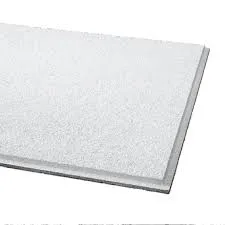Dec . 23, 2024 04:28 Back to list
mineral wool ceiling
The Benefits of Mineral Wool Ceiling Tiles An Acoustic and Thermal Insulation Solution
Mineral wool, or rock wool, has emerged as a popular choice for ceiling tiles due to its exceptional acoustic and thermal insulation properties. This innovative material is made from natural rock or minerals, which are melted and spun into fibers, creating a dense and resilient product. As construction and interior design evolve, many builders and homeowners are turning to mineral wool ceiling tiles to enhance the functionality and aesthetics of their spaces.
Acoustic Performance
One of the primary advantages of mineral wool ceiling tiles is their outstanding sound absorption capabilities. In commercial buildings, offices, and even residential spaces, noise pollution can be a significant concern. Open-concept designs, hard surfaces, and busy environments often lead to echoes and disruptive sounds. Mineral wool ceiling tiles are engineered to significantly reduce the transmission of sound between spaces, making them an ideal choice for theaters, conference rooms, and learning environments where concentration and communication are essential.
The sound-absorbing properties of mineral wool are attributed to its porous structure. When sound waves reach the ceiling, they penetrate the material, causing the fibers to vibrate and dissipate the sound energy. This reduces reverberation time, leading to a quieter, more comfortable atmosphere. By installing mineral wool ceiling tiles, property owners can create an environment that enhances productivity, learning, and relaxation.
Thermal Insulation
Beyond acoustics, mineral wool ceiling tiles are excellent insulators, helping to maintain a comfortable indoor temperature. The material has a low thermal conductivity, which means it effectively resists the transfer of heat. In both cold and warm climates, this feature can lead to significant energy savings. By preventing heat loss in winter and keeping spaces cool during summer, mineral wool ceiling tiles contribute to a more energy-efficient building.
mineral wool ceiling

In addition to energy savings, mineral wool ceiling tiles can also contribute to a building's sustainability. Many manufacturers produce these tiles using recycled materials, and they themselves can be recycled after their lifespan. By choosing mineral wool for your ceiling, you are not only investing in a high-performance solution but also fostering environmentally responsible choices.
Fire Resistance
Safety is a paramount concern in any building design, and mineral wool tiles offer impressive fire-resistant qualities. Being non-combustible, mineral wool ceiling tiles can withstand high temperatures without contributing to flame spread. This makes them an ideal choice for commercial and industrial environments where fire safety regulations are stringent. By incorporating these tiles into your design, you can enhance the overall safety of your building and provide peace of mind for occupants.
Versatility and Aesthetics
Mineral wool ceiling tiles are available in a wide array of designs, textures, and colors, allowing for creativity and flexibility in interior design. Whether you prefer a sleek, modern look or a more traditional appearance, there are options to suit every aesthetic preference. They can be installed in various grid systems, making them an adaptable solution for different architectural styles and requirements.
Conclusion
Incorporating mineral wool ceiling tiles into your building offers a myriad of benefits ranging from superior acoustic and thermal performance to fire resistance and aesthetic versatility. As the demand for sustainable, high-performance building materials continues to grow, mineral wool stands out as an excellent choice for architects, builders, and homeowners alike. By choosing mineral wool, you invest in a solution that enhances comfort, safety, and sustainability, paving the way for a better living and working environment.
-
Durable Ceiling T Grid Systems | Easy InstallationNewsAug.29,2025
-
PVC Gypsum Ceiling: Durable, Laminated Tiles for Modern SpacesNewsAug.28,2025
-
Pvc Gypsum Ceiling Is DurableNewsAug.21,2025
-
Mineral Fiber Board Is DurableNewsAug.21,2025
-
Ceiling Tile Clip Reusable DesignNewsAug.21,2025
-
Ceiling T Grid Modular DesignNewsAug.21,2025







